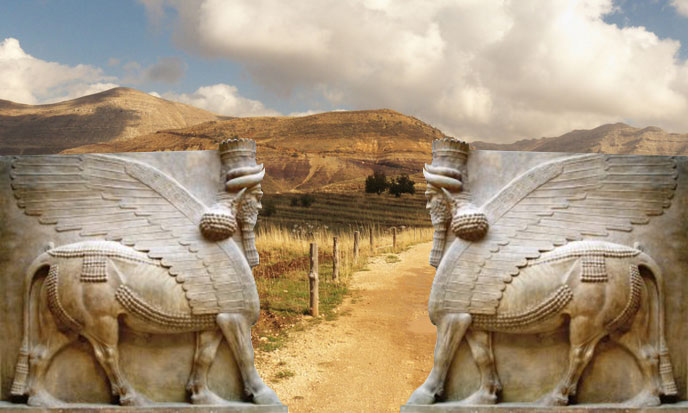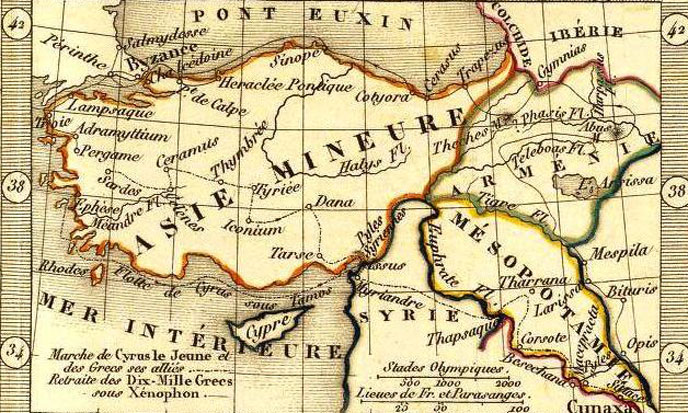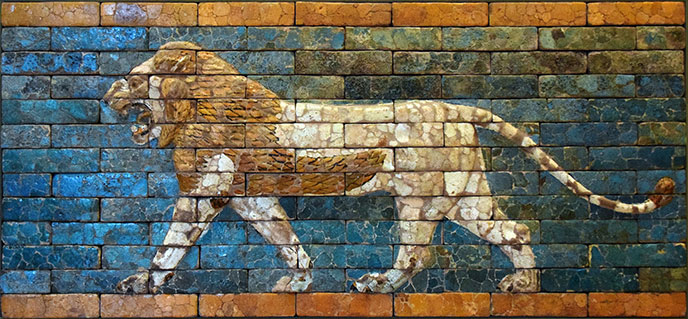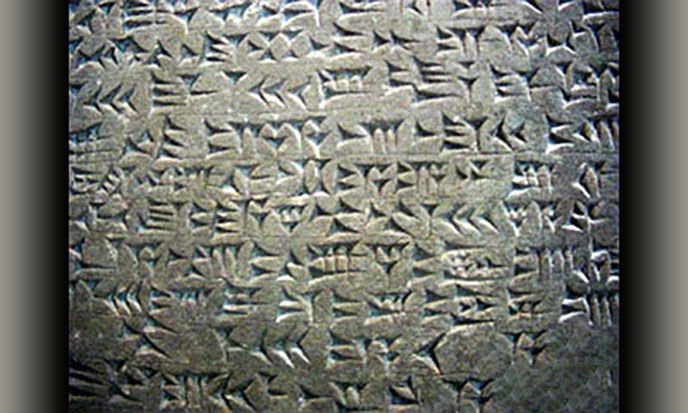
For any reason, the Neolithic Revolution began in Sumer, in this little bit of fertile crescent called Mesopotamia: the plain between the rivers.
Few places on this planet have been identified as sources of civilization. On the other side of the Atlantic, Mesoamerica is one. In the Mediterranean area and more generally in the Middle East, Mesopotamia is another one. Medi, meso, medium, many ways to name the middle: humans were once living in Middle-earth, as Tolkien told in Lord of the Rings.
An incredible number of civilizations have succeeded in the Middle East, the most notable being Sumer. Middle East has the oldest known cities: Assur, Uruk, Ur, Babylon, Göbekli Tepe, Çatalhöyük, and the underground cities of Cappadocia, among other sites. Our civilization has made its first flight in the fertile crescent between the Tigris and Euphrates rivers that both irrigate Mesopotamia. This country ‘between two rivers’ includes north a plateau region, rainfed area, and south, a region of plains where irrigation is needed.
“The fertile crescent is an area where irrigation is not necessary: wet, the soils are easy to grow. It includes the region that lies south of Mesopotamia, where drought makes irrigation necessary. In this very place the Neolithic Revolution occurred 10,000 years ago. The term “Mesopotamia” refers to the ancient history of this region, to the civilization which has occupied this space since the last centuries BCE until the sixth century before the Muslim era.” (source)Wikipedia

In Sumer, there was a mountainous area called Kharsag, “the entrenched plateau”. There was also an irrigated lowland called Edin, “the plain”. In this “plain” the nascent humanity was parked by their creators, the Anunna, who were some of the Former Gods.
Humanoid cattle was indeed closer to livestock than to today humankind. Although … to look at some neo-fascist morons, is doubtful of progress. Anyway, the humans were allegedly created by “pseudo-gods“, who were not at all God like we represent today. They were human beings like us, except they were very developed.
Technocrats, scientists, astronauts, engineers, geneticians surrounded by a farmyard of human newborns: us, designed to be the succession of the Giants. With extreme care, the terraforming Giants have shaped us in their genetics laboratories, all on the same model or rather on seven different models, the seven daughters of Eve identified by geneticists. Probably because they needed manpower after a devastating cataclysm. Sumerian, tablets say that their former manpower, ie the Angels or Giants, were totally unable to grow plants, and the Gods wanted vegetables badly.
They have created us small because they had no choice. Our small fingers are perfect to handle seeds. After our origin as described by the Assyrian tablets, what happened in Edin? The presence of man is attested since -9000. Then, around -7000, pottery made its first appearance. Clear signs of early domestication of animals and plants also appear: first appearance of agriculture around -10,000 in Egypt, then -8000 in Sumer where the use of brick for the first time demonstrates existence of village life …
For the first time? This is doubtful … It was the first time only for those who accept the falsely admitted dating of Cyclopean cities, of the Giza pyramids in Egypt, and other megalithic walls, which are probably much older.
Around -6000, we note also the use of copper, the use of irrigation in agriculture, the emergence of the stamp seals, murals, painted, incised or decorated ceramic, as well as the first shrine and a widespread use of sun dried brick.

Then, there are three successive cultures: Hassuna, Samarra and Halaf. Please note that given datation represents the official Historians and Archeologists point of view. This datation is subject to a reasonnable doubt. During this era, the human is still very primitive, despite paradoxical traces of developed civilization.
Sumerian texts explain this paradox by the sudden coming of astronaut gods. They taught us everything, said the ancient texts. Before they came, humans were like beasts, unable to stand and drinking water in the ditches. The Terraforming Gods were considering humans as work in progress, they know how much time our ancestor needed to develop.
Then come two phases when social complexity increased, until the constitution of real states. The creation of a first form of writing tilts Mesopotamia in History with Obeid and Uruk. Note that Uruk was the city of the legendary Gilgamesh, who declared himself the first king of men, implying that before him, only the Former Gods ruled over the human cattle.
The historical period begins in Mesopotamia around 3400, when the writing is developed. After the reign of King Gilgamesh and his futile quest for immortality came the end of the golden age. The history then welcomes the emergence of city-states in Lower Mesopotamia. Writing develops, but the texts written during this period are still difficult to interpret, and it is only paperwork and lexical lists, which tell us nothing about the history of events.
From the middle of the third millennium, we are informed about events, primarily through the archives found at Lagash, and the Assyrian tablets. Second, is the domination of Akkad, where King Sargon terminates the period of city-states by uniting them in a real empire.
Neo–Sumerian: The Empire of Akkad collapsed because riots and attacks on “barbarian” peoples. The Sumerian city-states regain their independence before being unified by the founding kings of the 3rd dynasty of Ur.
Amorrite: The kingdom of Ur collapsed around 2000, when various kingdoms of Mesopotamia share. Babylon came to dominate the entire region during the reign of Hammurabi to the capture of the city by the Hittites around -1595.
Kassite: The new dynasty dominates Babylon for more than four centuries. The period ends with a serious crisis, invasion of the Arameans.
Neo-Assyrian: The Assyrians restore their power, their empire dominating the entire Middle East.
Neo-Babylonian: The Babylonians to resume their profit part of the Neo-Assyrian Empire, notably through the action of Nebuchadnezzar II.
Achaemenid-539 -331: Mesopotamia is under the domination of Iran, a period of great prosperity.
Seleucid:-331 -140 The Achaemenid Persian Empire fell under the blows of Alexander the Great.Parthian: After much discussion, the Parthians drove the Seleucids of Mesopotamia. (source)Wikipedia

Through all these hazards has written a story of incomparable richness. Consider that during the same period, the Neolithic is sufficient to describe the history of the hexagon until the arrival of the Celts or Gauls to -600.
Before, nothing remarkable, because the absence of writing does not allow chronic. However, the absence of proof does not constitute the proof of absence. Celtic and Hyperborean influence is more important than our history textbooks teach us. It is even capital. If civilization starts at Sumer, it is not because men were more evolved. It is because the former gods had installed several astroports in the neighborhoods: the astroport of Baalbek and that of Babel, as will see it further. That’s where they laid their rockets, that’s where they started teaching humans. But the gods came from elsewhere …
The absence of writing does not mean that pre-Celtic populations were not advanced, as attested by the lack of fortifications around the Neolithic villages. In any case, the Atlanteans knew the writing. Their megalithic descendants, the Tuatha or Ligurians, used a sacred runic writing. The writing existed in Mu and among Quetzalcoatl that have been post-dated by prevailing archeology. It may have existed in Glozel, in a prehistoric version. But the archaeological weight requires that writing was born in the Middle East, cultural melting pot and home of the three revealed religions.
This event wealth can only reinforce the image of the founding of civilizations Edin, the vast plain. In an attempt to match the legend with the story, it would date the creation of man by the Anunna at the dawn of the Neolithic, around 10,000. Slight problem: the presence of man is attested for much longer.
The Anunna did not create man, they have besides faced with other giants, the planning Powers: probably the Elohim. The age of our species is counted in hundreds of millions of years. They found bones and fossilized footprints which attest the presence of modern humans, although variable in size, in the tertiary and secondary eras.
Man has tamed the dinosaurs. Long before the Anunna, this planet was inhabited. They only added their note to an immemorial symphony… For human was not done in one day. Nor even in seven! There have been many versions, adapted to the hazards of this planet. Human went through countless cataclysms, and has always get through. Let’s hope it lasts…
History like time is cyclical. What has been will be. Long ago insolent Babel defied flying gods in their strange machine. The Babelians built a tower to be their own launchpad for their own rocket. The Babelians wanted to get to Nibiru, ie the mothership of the Anunna Gods, which was called Hyperborea in Europe.

The Anunna didn’t like that. Babel was destroyed and Babelians scattered over the face of the earth. To break definitively their plot against their masters from the sky, the Anunnaki troubled human heads and words: we began to speak different languages.
Ifever our manufacturers took a fancy to land back here to quarrel and claim, will we all speak the same language? They will come back because they are the masters of Ki, this planet. They will come back, because this is their job. These people, our masters, are terraforming gods.


